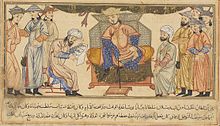Battle of Kerj Abu Dulaf
| Battle of Kerj Abu Dulaf | |||||||
|---|---|---|---|---|---|---|---|
| Part of Seljuk Civil War | |||||||
 Malik-Shah I seated on his throne, miniature from the Jami' al-tawarikh of Rashid al-Din Hamadani | |||||||
| |||||||
| Seljuk Civil War | |||||||
| Seljuk Empire | Kerman Seljuk Sultanate | ||||||
| Commanders and leaders | |||||||
|
Malik-Shah I Nizam al-Mulk |
Qavurt (POW) † Sultan-shah (POW) | ||||||
| Strength | |||||||
| Unknown | Unknown | ||||||
| Casualties and losses | |||||||
| Unknown | Unknown | ||||||
Battle of Kerj Abu Dulaf was fought in 1073 between the Seljuk Army of Malik-Shah I and Kerman Seljuk army of Qavurt and his son, Sultan-shah. It took place approximately near Kerj Abu Dulaf, the present-day between Hamadan and Arak, and was a decisive Malik-Shah I victory.
After death Alp-Arslan, Malik-Shah was declared as the new sultan of the empire. However, right after Malik-Shah accession, his uncle Qavurt claimed the throne for himself and sent Malik-Shah a message which said: "I am the eldest brother, and you are a youthful son; I have the greater right to my brother Alp-Arslan's inheritance." Malik-Shah then replied by sending the following message: "A brother does not inherit when there is a son.".[1] This message enraged Qavurt, who thereafter occupied Isfahan. In 1073 a battle took place near Hamadan, which lasted three days. Qavurt was accompanied by his seven sons, and his army consisted of Turkmens, while the army of Malik-Shah consisted of ghulams ("military slaves") and contingents of Kurdish and Arab troops.[1]
During the battle, the Turks of Malik-Shah's army mutinied against him, but he nevertheless managed to defeat and capture Qavurt.[2][3] Qavurt then begged for mercy and in return promised to retire to Oman. However, Nizam al-Mulk declined the offer, claiming that sparing him was an indication of weakness. After some time, Qavurt was strangled to death with a bowstring, while two of his sons were blinded. After having dealt with that problem, Malik-Shah appointed Qutlugh-Tegin as the governor of Fars and Sav-Tegin as the governor of Kerman.[4]
References
[edit]- ^ a b Bosworth 1968, p. 88.
- ^ Durand-Guédy 2012.
- ^ Bosworth 1968, pp. 88–89.
- ^ Bosworth 1968, p. 89.
Sources
[edit]- Wikipedia contributors. (2019, August 5). Kerman Seljuk Sultanate. In Wikipedia, The Free Encyclopedia. Retrieved 12:48, September 13, 2019, from http://fa.wiki.x.io/wiki/سلجوقیان_کرمان
- Bosworth, C. E. (1968). "The Political and Dynastic History of the Iranian World (A.D. 1000–1217)". In Frye, R. N. (ed.). The Cambridge History of Iran, Volume 5: The Saljuq and Mongol periods. Cambridge: Cambridge University Press. pp. 1–202. ISBN 0-521-06936-X.
- Durand-Guédy, David (2012). "MALEKŠĀH". Encyclopaedia Iranica.
